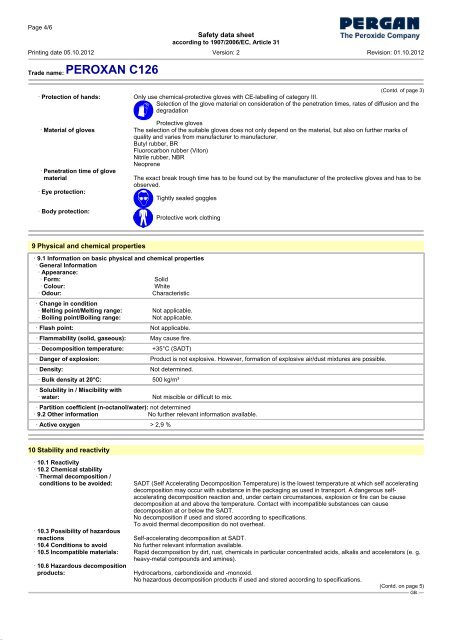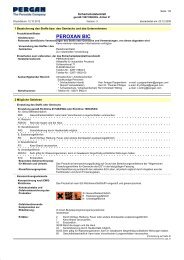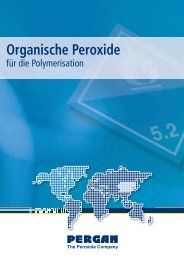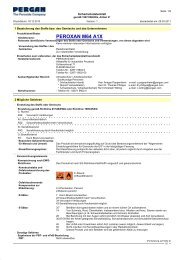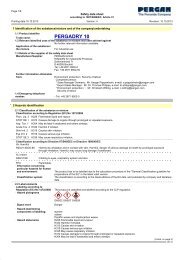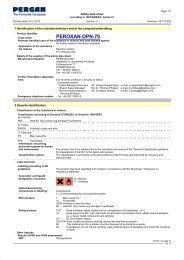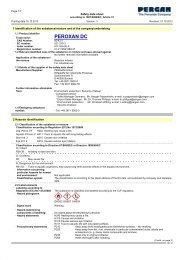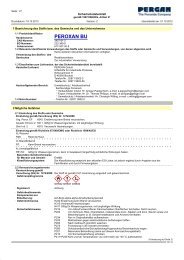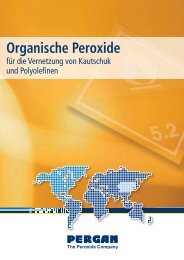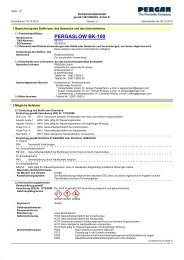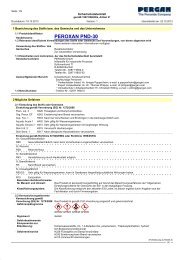PEROXAN C126 - Pergan GmbH
PEROXAN C126 - Pergan GmbH
PEROXAN C126 - Pergan GmbH
You also want an ePaper? Increase the reach of your titles
YUMPU automatically turns print PDFs into web optimized ePapers that Google loves.
35.0.29<br />
Page 4/6<br />
Printing date 05.10.2012<br />
Safety data sheet<br />
according to 1907/2006/EC, Article 31<br />
Version: 2<br />
Revision: 01.10.2012<br />
Trade name: <strong>PEROXAN</strong> <strong>C126</strong><br />
(Contd. of page 3)<br />
· Protection of hands: Only use chemical-protective gloves with CE-labelling of category III.<br />
Selection of the glove material on consideration of the penetration times, rates of diffusion and the<br />
degradation<br />
`S<br />
Protective gloves<br />
· Material of gloves The selection of the suitable gloves does not only depend on the material, but also on further marks of<br />
quality and varies from manufacturer to manufacturer.<br />
Butyl rubber, BR<br />
Fluorocarbon rubber (Viton)<br />
Nitrile rubber, NBR<br />
Neoprene<br />
· Penetration time of glove<br />
material The exact break trough time has to be found out by the manufacturer of the protective gloves and has to be<br />
observed.<br />
· Eye protection:<br />
Tightly sealed goggles<br />
· Body protection:<br />
`R<br />
9 Physical and chemical properties<br />
Protective work clothing<br />
· 9.1 Information on basic physical and chemical properties<br />
· General Information<br />
· Appearance:<br />
· Form: Solid<br />
· Colour: White<br />
· Odour: Characteristic<br />
· Change in condition<br />
· Melting point/Melting range: Not applicable.<br />
· Boiling point/Boiling range: Not applicable.<br />
· Flash point: Not applicable.<br />
· Flammability (solid, gaseous): May cause fire.<br />
· Decomposition temperature: +35°C (SADT)<br />
· Danger of explosion: Product is not explosive. However, formation of explosive air/dust mixtures are possible.<br />
· Density: Not determined.<br />
· Bulk density at 20°C: 500 kg/m³<br />
· Solubility in / Miscibility with<br />
· water: Not miscible or difficult to mix.<br />
· Partition coefficient (n-octanol/water): not determined<br />
· 9.2 Other information No further relevant information available.<br />
· Active oxygen > 2,9 %<br />
10 Stability and reactivity<br />
· 10.1 Reactivity<br />
· 10.2 Chemical stability<br />
· Thermal decomposition /<br />
conditions to be avoided: SADT (Self Accelerating Decomposition Temperature) is the lowest temperature at which self accelerating<br />
decomposition may occur with substance in the packaging as used in transport. A dangerous selfaccelerating<br />
decomposition reaction and, under certain circumstances, explosion or fire can be cause<br />
decomposition at and above the temperature. Contact with incompatible substances can cause<br />
decomposition at or below the SADT.<br />
No decomposition if used and stored according to specifications.<br />
To avoid thermal decomposition do not overheat.<br />
· 10.3 Possibility of hazardous<br />
reactions Self-accelerating decomposition at SADT.<br />
· 10.4 Conditions to avoid No further relevant information available.<br />
· 10.5 Incompatible materials: Rapid decomposition by dirt, rust, chemicals in particular concentrated acids, alkalis and accelerators (e. g.<br />
heavy-metal compounds and amines).<br />
· 10.6 Hazardous decomposition<br />
products: Hydrocarbons, carbondioxide and -monoxid.<br />
No hazardous decomposition products if used and stored according to specifications.<br />
(Contd. on page 5)<br />
GB


